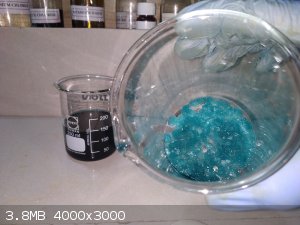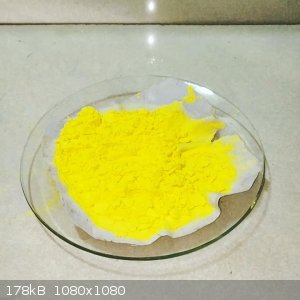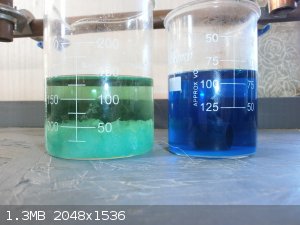vibbzlab
Hazard to Others
  
Posts: 241
Registered: 6-11-2019
Member Is Offline
Mood: Always curious
|
|
Purify ferrous sulfate
I tried to make ferrous sulfate by adding Sulfuric acid to scrap stainless steel and I got green crystals from that. But seeing the colour of it I
think there is good amount of contaminants in it probably chromium. Is there any way to purify it

Amateur chemist. Doctor by profession
Have a small cute home chemistry lab.

Please do check out my lab in YouTube link below
This is my YouTube channel |
|
|
Bedlasky
International Hazard
    
Posts: 1219
Registered: 15-4-2019
Location: Period 5, group 6
Member Is Offline
Mood: Volatile
|
|
Pure FeSO4 looks similiary like your crystals. Look on crystalgrowing. But if you use staniless steel as a source of iron, it contain some Ni and Cr salts. Cr salts can be removed by just dissolving
crystals and addition of excess of NaOH. Fe and Ni precipitates and Cr stay in solution. Ni can be dissolved by addition of ammonia. Then filtered
your Fe precipitate, dissolve it in sulfuric acid, add few iron nails and boil it for few minutes. Iron nails reduce any Fe(III) in solution in to
Fe(II).
|
|
|
vibbzlab
Hazard to Others
  
Posts: 241
Registered: 6-11-2019
Member Is Offline
Mood: Always curious
|
|
Thanks for that .So I will dissolve it in minimum amount of water to make a solution and then add concentrated sodium hydroxide in excess right?
Then I would add ammonia into it? Or should I filter the precipitate first then add ammonia? After that I should filter the ppt and then add Sulfuric
acid with iron nails and boil that for few minutes and recrystallise right
Amateur chemist. Doctor by profession
Have a small cute home chemistry lab.

Please do check out my lab in YouTube link below
This is my YouTube channel |
|
|
unionised
International Hazard
    
Posts: 5102
Registered: 1-11-2003
Location: UK
Member Is Offline
Mood: No Mood
|
|
I would start by taking a little of it, rinsing it and then dissolving it in water in a test tube.
Then add excess ammonia, and filtering it.
Cr and Ni will dissolve as amine complexes and pass through the filter.
If the filtrate is colourless then there's not enough Ni or Cr to worry about.
|
|
|
vibbzlab
Hazard to Others
  
Posts: 241
Registered: 6-11-2019
Member Is Offline
Mood: Always curious
|
|
By excess ammonia how much do you mean. Can you tell
Amateur chemist. Doctor by profession
Have a small cute home chemistry lab.

Please do check out my lab in YouTube link below
This is my YouTube channel |
|
|
unionised
International Hazard
    
Posts: 5102
Registered: 1-11-2003
Location: UK
Member Is Offline
Mood: No Mood
|
|
Until no more precipitate forms when you add more, the solution stops changing colour (apart from getting a little paler because it becomes more
dilute) and the mixture smells strongly of ammonia.
|
|
|
garphield
Hazard to Self
 
Posts: 58
Registered: 9-12-2019
Member Is Offline
|
|
i'm really new to the forum, can someone explain to me why recrystallizing it won't work? Only thing I can think of is that Fe, Ni, and Cr similar
enough that they can replace each other in the crystal structure so they all crystallize out together but i don't know if that's right. Thanks.
|
|
|
Bedlasky
International Hazard
    
Posts: 1219
Registered: 15-4-2019
Location: Period 5, group 6
Member Is Offline
Mood: Volatile
|
|
Because this is much easier method of separation. Another benefit is that you have higher yield because losses from precipitation are much lower than
losses from multiple recrystallizations.
|
|
|
unionised
International Hazard
    
Posts: 5102
Registered: 1-11-2003
Location: UK
Member Is Offline
Mood: No Mood
|
|
Cr(III) is not likely to be incorporated into the FeSO4- the charge is "wrong" so it won't fit properly.
But Ni (and Cu and Mn + Zn) if they are there will co crystallise.
|
|
|
vibbzlab
Hazard to Others
  
Posts: 241
Registered: 6-11-2019
Member Is Offline
Mood: Always curious
|
|
I think adding ammonia and refiltering the solution then adding Sulfuric acid again isn't that hard
Amateur chemist. Doctor by profession
Have a small cute home chemistry lab.

Please do check out my lab in YouTube link below
This is my YouTube channel |
|
|
CharlieA
National Hazard
   
Posts: 645
Registered: 11-8-2015
Location: Missouri, USA
Member Is Offline
Mood: No Mood
|
|
Just a general comment to be taken with a grain of salt (NaCl?) by anyone who reads it: many (not all) questions about separating inorganic species
could be answered by referring to qualitative analytical chemistry and/or qualitative analytical chemistry textbooks.
Merry Christmas/ Seasons Greetings...Charlie
|
|
|
vibbzlab
Hazard to Others
  
Posts: 241
Registered: 6-11-2019
Member Is Offline
Mood: Always curious
|
|
I have decided to convert all that stainless steel sulfate solution into ferrous oxalate thereby I can get pure iron as we can precipitate out that
compound with oxalic acid
Amateur chemist. Doctor by profession
Have a small cute home chemistry lab.

Please do check out my lab in YouTube link below
This is my YouTube channel |
|
|
Amos
International Hazard
    
Posts: 1406
Registered: 25-3-2014
Location: Yes
Member Is Offline
Mood: No
|
|
I would honestly simply recrystallize your ferrous sulfate from boiling water when you have a significant quantity of the crude product. Chromium(III)
compounds form extremely hygroscopic coordination complexes containing water ligands after being heated above 40C, and they're very slow to exchange
ligands thereafter. Simply re-crystallizing and then washing your crystals with ice water should remove chromium and nickel sulfates, the latter of
which is far more soluble than FeSO4.
|
|
|
TGSpecialist1
Hazard to Self
 
Posts: 53
Registered: 24-12-2017
Member Is Offline
Mood: always tired
|
|
As you and others said, you can remove chromium by recrystallising (just keep solution acidic to prevent Cr(OH)3 from forming), but is won't remove
nickel, it forms shared crystals with FeSO4. Starting over with scrap cast iron or steel wool would be more cost effective than removing nickel.
|
|
|
Bedlasky
International Hazard
    
Posts: 1219
Registered: 15-4-2019
Location: Period 5, group 6
Member Is Offline
Mood: Volatile
|
|
Quote: Originally posted by vibbzlab  | | I have decided to convert all that stainless steel sulfate solution into ferrous oxalate thereby I can get pure iron as we can precipitate out that
compound with oxalic acid |
Nickel oxalate is insoluble as well.
|
|
|
elementcollector1
International Hazard
    
Posts: 2684
Registered: 28-12-2011
Location: The Known Universe
Member Is Offline
Mood: Molten
|
|
Could go the other way and complex out the iron with some H2O2... sodium triferrooxalate is also a pretty crystal to grow.
Elements Collected:52/87
Latest Acquired: Cl
Next in Line: Nd
|
|
|
Amos
International Hazard
    
Posts: 1406
Registered: 25-3-2014
Location: Yes
Member Is Offline
Mood: No
|
|
Maybe I'm exposing a blind spot in my inorganic chemistry knowledge, but why is everyone suggesting that nickel will co-crystallize with iron when
nickel(II) sulfate is approximately 4 times more soluble in room-temperature water and the most common hydrates have vastly different crystal
structures?
|
|
|
vibbzlab
Hazard to Others
  
Posts: 241
Registered: 6-11-2019
Member Is Offline
Mood: Always curious
|
|
I have found that it's really contaminated with chromium. I got several ideas to seperate it. People told me to use alcohol as a medium because
chromium sulfate is easily soluble in methanol. And ferrous sulfate seperates which can just crystalise out.
I also tried to seperate out iron oxalate crystals by adding a concentrated solution of oxalic acid into it.
Here is the preparation video
https://youtu.be/hQ3YwDnYdYk
sulfate precipitate out as yellow colored solution.
Amateur chemist. Doctor by profession
Have a small cute home chemistry lab.

Please do check out my lab in YouTube link below
This is my YouTube channel |
|
|
woelen
Super Administrator
        
Posts: 7976
Registered: 20-8-2005
Location: Netherlands
Member Is Offline
Mood: interested
|
|
Quote: Originally posted by vibbzlab  | | I tried to make ferrous sulfate by adding Sulfuric acid to scrap stainless steel and I got green crystals from that. But seeing the colour of it I
think there is good amount of contaminants in it probably chromium. Is there any way to purify it |
This is not the color of FeSO4.7H2O. The latter has a fairly pale mint green color, not the strong green color of your material.
Here is a picture of pure ferrous sulfate:
https://woelen.homescience.net/science/chem/compounds/ferrou...
[Edited on 15-1-20 by woelen]
|
|
|
rockyit98
Hazard to Others
  
Posts: 283
Registered: 12-4-2019
Location: The Known Universe
Member Is Offline
Mood: no mood is a good mood
|
|
if you need pure FeSO4 then react H2SO4 with Electrical steel https://en.wikipedia.org/wiki/Electrical_steel it a alloy of Fe and Si with often no other impurity's Si won't get dissolved. in Hit can get from
old transformer(I and E shaped plates). keep in mind they have thin layer of polymer that have to remove with sand paper.
please don't start arguments over pictures of compounds over the internet as ebay sellers say color may change display to display.
"A mind is a terrible thing to lose"-Meisner
|
|
|
vibbzlab
Hazard to Others
  
Posts: 241
Registered: 6-11-2019
Member Is Offline
Mood: Always curious
|
|
Finally I was able to get iron oxalate from that contaminated stainless steel solution by adding Sulfuric acid into it. I filtered the solution and
obtained the precipitate which I dried.i heated it to make the pyrophoric iron and it worked perfectly fine . I have added a picture of ferrous
oxalate here.
Here is the preparation video of the compound and the pyrophoric test
https://youtu.be/Yo7Im90rX2s

Amateur chemist. Doctor by profession
Have a small cute home chemistry lab.

Please do check out my lab in YouTube link below
This is my YouTube channel |
|
|
XeonTheMGPony
International Hazard
    
Posts: 1636
Registered: 5-1-2016
Member Is Offline
Mood: No Mood
|
|
If your target was Iron^2 Sulfate why did you decide to use stainless if I may ask?
I needed some for a catalyst for making dioxane, so I used black iron gas pipe (Just carbon steel)
So just filtered out the carbon after I had boiled the solution with excess iron pipe.
Yield was nice pale green iron 2 sulfate.
to the right is Copper Nitrate to contrast the color

|
|
|